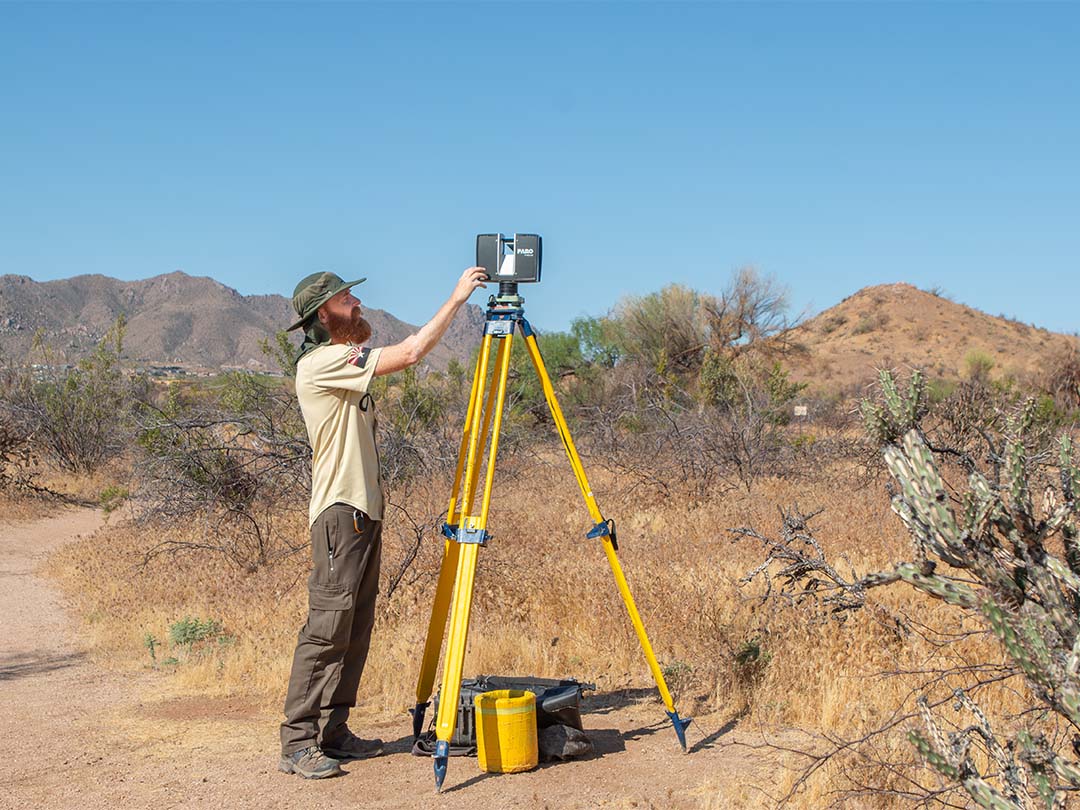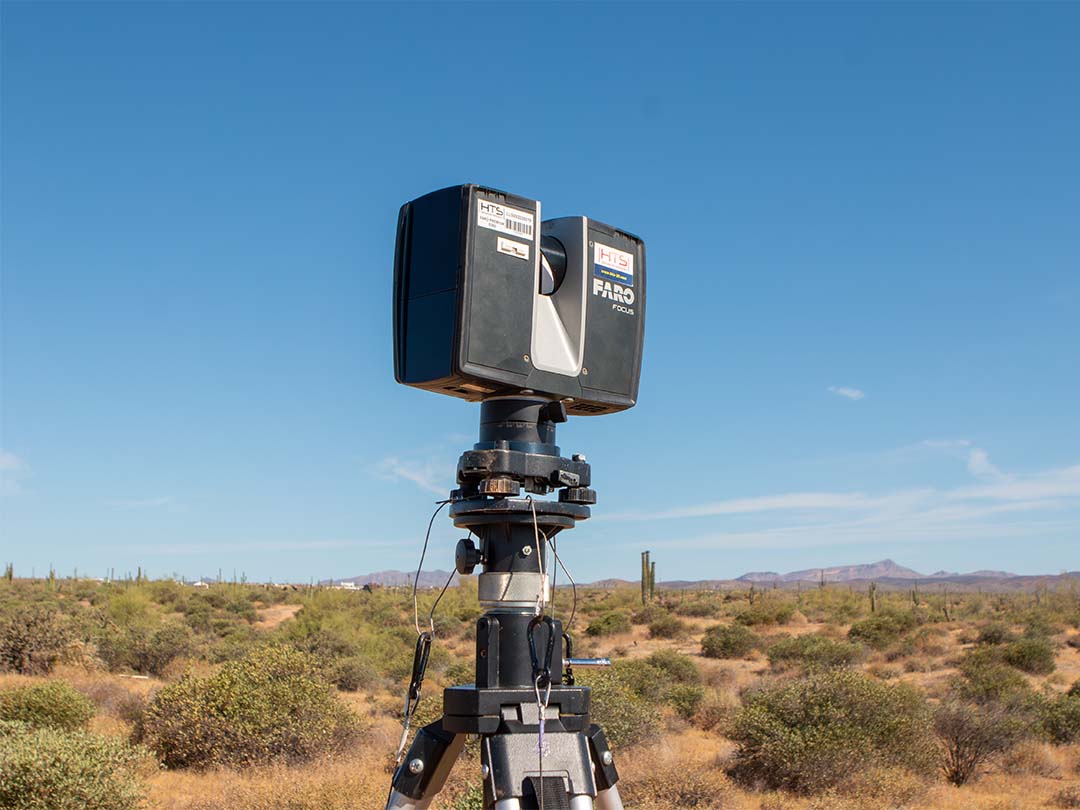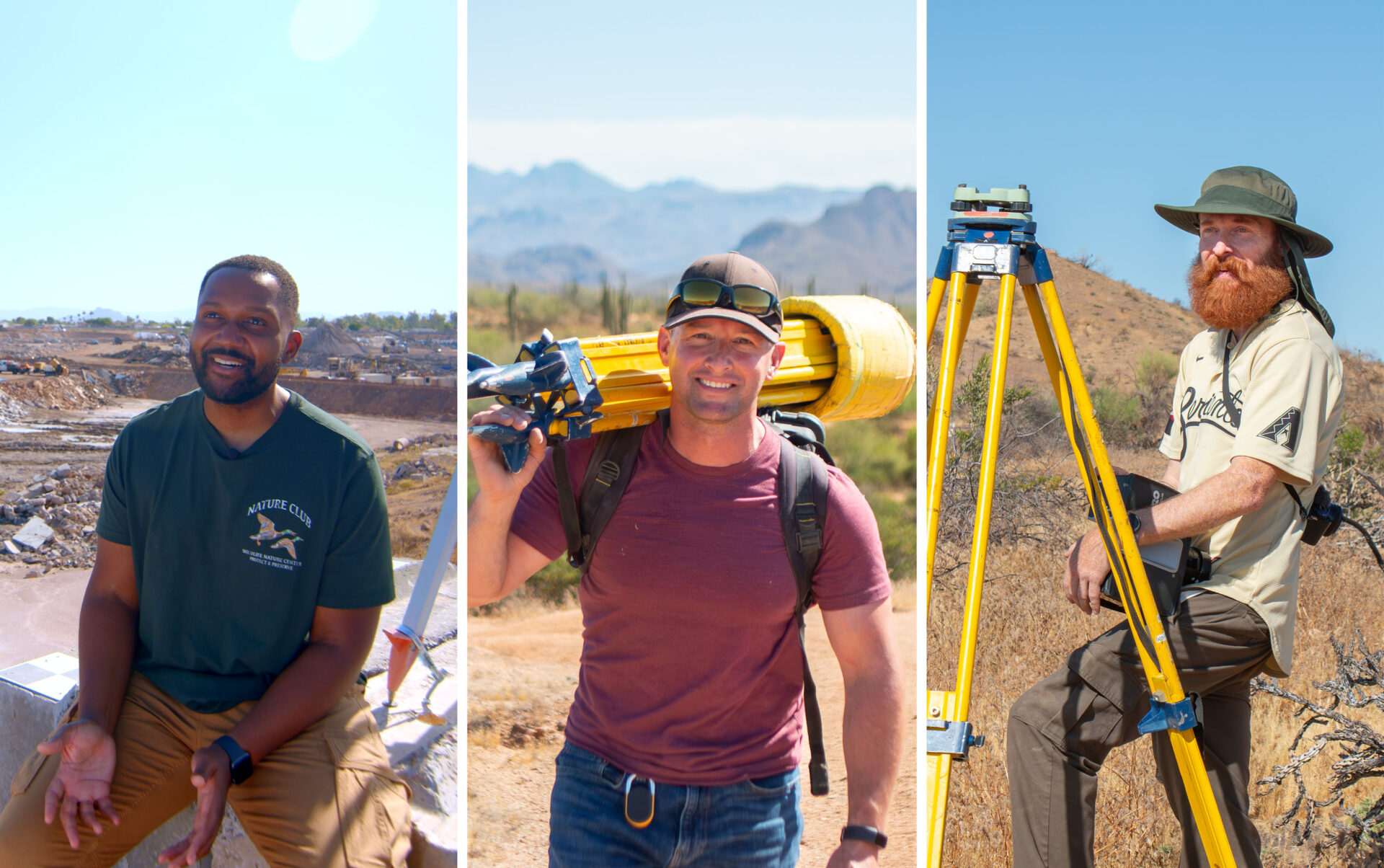It’s a sweltering morning in early June, and Charles Darr prepares to set up a 3D laser scanner that will capture images, or scans, of the entire scenery at an undisclosed site at the McDowell Mountain Preserve.
He quickly unloads 70 pounds of gear off his shoulders, including a heavy-duty tripod, a 3D LiDAR scanner and precision spheres, that will capture a 360 survey of the landscape. As the temperature creeps up to 100 degrees, he patiently waits for the scan to finish.

Darr is one of three 3D Scanning Artists contracted by the Garden for its next major exhibition DESERT PULSE, arriving in the fall of 2025. The unique exhibit, by London-based design studio ScanLAB Projects, will showcase the Sonoran Desert in a dimension impossible to see with the naked eye or through the lens of a traditional camera. Guests will experience a stunning display of the desert, from cactus flowering and fruiting, shifting sediment patterns along the Salt River and even man-made impacts in the Valley. The project is a heavy undertaking that requires a dedicated team of scanners, who collect daily scans in 15 distinct locations.
The job is hard. From October 2023 through October 2024, scanners have to hike, offroad, carry heavy equipment, brave the weather, take traditional photographs and travel many miles to get to all 15 locations. Still, one of the most important responsibilities of the role is precision. Each scan can take 10 minutes or half an hour to complete. At all sites, scans and photographs are captured at exact spots that will then be used in ScanLAB’s software to design a masterpiece never before seen at this scale at the Garden.
“Each scan is going to end up being 1/25th of a second in the timelapse. Not only are we doing LiDAR scans, we are doing photography. We are super-imposing color data on top of the scans. Not only are you going to see stuff change, but you are going to see the shadows stretch out in the winter and retreat in the summer,” says Darr, who started at the onset of the project.
A Phoenix native, Darr holds a master’s degree in sustainability from Arizona State University. He is freelance photographer and videographer and volunteers for several nonprofits, including Skate After School, a local program that teaches kids in underserved communities how to skate. Darr is even a skater himself.
Eight months into the role, he’s traversed several iconic Valley sites, often seeing free-roaming cattle cross highways, a host of wildlife at the Salt River and has had many interactions with people — all curious about his endeavors in scanning these sites. Though he grew up in Arizona, the role has helped him explore new areas.
“I spent a lot of time at the Four Peaks recreational area, but I wasn’t as familiar with the Rio Verde region. And so, it’s nice to be out there and explore that,” he says. “Did you know Arizona has freshwater otters?”
He says he was surprised to discover the furry aquatic animals while out in the field.

Kyleif Cade had only been living in Phoenix for a year before beginning his role on the DESERT PULSE project. Cade was born in California, grew up in Tennessee and prior to moving to Arizona had preconceived ideas about life in the desert.
“Being new to the desert I did not know that it had as much greenery as it did … I thought ‘what are we going to capture? Dust and tumbleweed’ but there’s been so much life … It’s thriving out here. That’s been one of the most pleasant surprises,” hey says.
Cade’s background is as a Cinematographer and 3D Motion Graphics Artist. However, he describes the role of a 3D Scanning Artist as the most unique job he’s ever had.
“This job has had a big impact on the way I go about my daily life. Being able to come out here and capture these daily changes has honestly made me more appreciative of nature itself … We live because these trees are pumping oxygen, we’re so intertwined and a lot of times we completely forget. So it’s helped me to slow down and appreciate that relationship and what’s around me,” Cade continued.

For scanner Richard White-Pickett, the project has allowed him to witness first-hand the evolving nature of the Sonoran Desert right in front of his eyes.
“Although it’s the same act every single day, we are getting to see all the amazing things that are going to be showcased in the story of DESERT PULSE. And I think that is the coolest part,” he says.
White-Pickett is a retired United States Marine who joined the scanning team full-time in January. He too is a photographer, capturing portraits for clients, sporting events, landscapes and so much more. He says his past experience has prepared him for his current role.
“I get between 15,000 to 20,000 steps a day. Considering my background, I was in the Marine Corps and did national security contracting, this is very much aligned with the life experiences I’ve had,” he says.
So, how are scans recorded?

Each scanner works alone and visits about 10-12 sites, including ones at Tonto National Forest, the Salt River and McDowell Mountain Preserve. It can take up to an hour to reach some of these sites. As the season has changed, they start their day early. Some begin their shift at 4 a.m. to beat the heat. They pack the scanning equipment that includes a black pelican case, a heavy-duty tripod and a black bag carrying precision spheres. The scanners also share a Rivian R1T pickup truck, which the electric vehicle manufacturer gifted as part of the project’s sustainability mission.
So far, the team has saved 187 gallons of fuel by using alternative-fuel vehicles.
At each spot, scanners mount the legs of the tripod on specially-designated points. These points were selected by Garden and ScanLAB staff to capture the exact 3D image each time scanners visit the sites.
Once the tripod is set, scanners place a LiDAR 3D scanner, which shoots an infrared laser that captures a 360 image of the environment. Then, they lay out precision spheres around the site that act as anchor points in postproduction.
Since the project started, scanners have gained an appreciation of the Sonoran Desert and wildlife. Each scan collected will be 1/25th of a second that will be utilized in the overall project. Once the exhibit is on display, guests will see the unraveling nature of the Sonoran Desert — a visual that is going to take a year to complete.
“What you get to see in a second of a frame in this project, I get to see in full view every single day. I get to watch the flowers bloom, I get to be a part of the story, and I think that is the coolest part,” White-Pickett says.
And it’s not just an artwork, the Garden hopes the data collected will contain empirical, measurable facts its researchers can use in their work.
“This project is a true intersection of art and science. The data that is gathered in the field every day is available to the Garden’s research team. We have already recognized patterns and movements in this data that we never would have discovered otherwise. It’s thrilling to see what has been captured,” Garden Senior Exhibits Director Laura Spalding Best says.
DESERT PULSE debuts at the Garden in the fall of 2025. For more information and updates, visit us at dbg.org.
